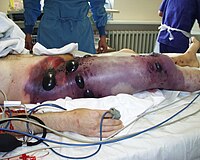
Photo from wikipedia
Using Illumina sequencing, we investigated transcriptional changes caused by the nematode Anguillicola crassus within yellow and silver eels by comparing swimbladder samples of uninfected yellow with infected yellow eels, and… Click to show full abstract
Using Illumina sequencing, we investigated transcriptional changes caused by the nematode Anguillicola crassus within yellow and silver eels by comparing swimbladder samples of uninfected yellow with infected yellow eels, and uninfected silver with infected silver eels, respectively. In yellow eel gas gland, the infection caused a modification of steady state mRNA levels of 1675 genes, most of them being upregulated. Functional annotation analysis based on GO terms was used to categorize identified genes with regard to swimbladder metabolism or response to the infection. In yellow eels, the most prominent category was ‘immune response’, including various inflammatory components, complement proteins, and immunoglobulins. The elevated expression of several glucose and monocarboxylate transporters indicated an attempt to maintain the level of glucose metabolism, even in due to the infection thickened swimbladder tissue. In silver eel swimbladder tissue, on the contrary, the mRNA levels of only 291 genes were affected. Genes in the categories ‘glucose metabolism’ and ‘ROS metabolism’ barely responded to the infection and even the reaction of the immune system was much less pronounced compared to infected yellow eels. However, in the category ‘extracellular matrix’, the mRNA levels of several mucin genes were strongly elevated, suggesting increased mucus production as a defense reaction against the parasite. The present study revealed a strong reaction to an Anguillicola crassus infection on mRNA expression levels in swimbladder tissue of yellow eels, whereas in silver eels the changes ware almost negligible. A possible explanation for this difference is that the silvering process requires so much energy that there is not much scope to cope with the additional challenge of a nematode infection. Another possible explanation could be that gas-secreting activity of the silver eel swimbladder was largely reduced, which could coincide with a reduced responsiveness to other challenges, like a nematode infection.
Journal Title: PLoS ONE
Year Published: 2017
Link to full text (if available)
Share on Social Media: Sign Up to like & get
recommendations!